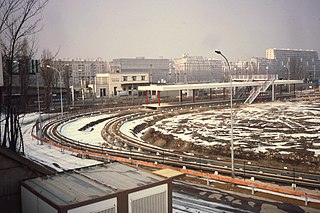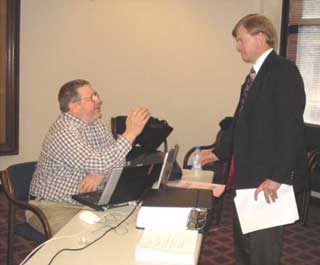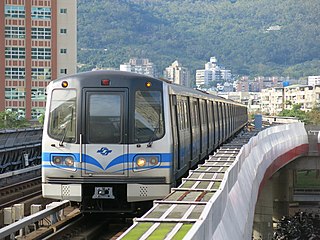Related Research Articles

Personal Rapid Transit (PRT), also referred to as podcars or guided/railed taxis, is a public transport mode featuring small low-capacity automated vehicles operating on a network of specially built guideways. PRT is a type of automated guideway transit (AGT), a class of system which also includes larger vehicles all the way to small subway systems. In terms of routing, it tends towards personal public transport systems.

A people mover or automated people mover (APM) is a type of small scale automated guideway transit system. The term is generally used only to describe systems serving relatively small areas such as airports, downtown districts or theme parks.

An automated guideway transit (AGT) or automated fixed-guideway transit or automatic guideway transit system is a type of fixed guideway transit infrastructure with a riding or suspension track that supports and physically guides one or more driverless vehicles along its length. The vehicles are often rubber tired or steel wheeled, but other traction systems including air cushion, suspended monorail and maglev have been implemented. The guideway provides both physical support, like a road, as well as the guidance.
Various terms are used for passenger railway lines and equipment; the usage of these terms differs substantially between areas:

The Aramis was an experimental personal rapid transit (PRT) system developed in France for deployment in the Paris area. Aramis included the unique feature of non-mechanical platooning that allowed the small cars to run as virtual trains in areas of higher transit density. This would allow the system to maintain high throughput in busy areas, with the trains breaking up into individual cars and going their separate ways as they approached their destination. In spite of considerable development, the platooning system was never made to work properly, and the cars tended to bump and jar in testing. The project was eventually shut down in November 1987, its place taken by the conventional Véhicule Automatique Léger system developed through the same period.
Cabinentaxi, sometimes Cabintaxi in English, was a German people mover development project undertaken by Demag and Messerschmitt-Bölkow-Blohm with funding and support from the Bundesministerium für Forschung und Technologie. Cabinentaxi was designed to offer low-cost mass transit services where conventional systems, like a metro, would be too expensive to deploy due to low ridership or high capital costs.

Morgantown Personal Rapid Transit is a personal rapid transit (PRT) system in Morgantown, West Virginia, United States. The system connects the three Morgantown campuses of West Virginia University (WVU) and the city's downtown area.

Pittsburgh Regional Transit is the second-largest public transit agency in Pennsylvania and the 20th-largest in the United States. The state-funded agency is based in Pittsburgh and is overseen by a CEO and a nine-member board of unpaid volunteer directors, five of whom are appointed by the county executive and approved by the county council; and one each by the majority and minority leaders by each political party. After operating as the Port Authority of Allegheny County for most of its history, the agency rebranded under its current name in June 2022. In 2022, the system had a ridership of 35,976,700.

Ultra is a personal rapid transit podcar system developed by the British engineering company Ultra Global PRT.

Gary Dean Zimmermann is an American politician and member of the Green Party of Minnesota in Minneapolis, Minnesota. He was an elected member of the Minneapolis City Council from 2001 to 2005. Before that, Zimmermann initially served on the Minneapolis Park Board as a member of the Minnesota Democratic-Farmer-Labor Party.
John Edward Anderson is an American engineer and proponent of personal rapid transit.
The Indianapolis Public Transportation Corporation, branded as IndyGo, is a public transit agency and municipal corporation of the City of Indianapolis in the U.S. state of Indiana. It operates fixed-route buses, bus rapid transit, microtransit, and paratransit services.
The Alden staRRcar, short for "Self-Transport Road and Rail Car", was a personal rapid transit (PRT) system designed by William Alden in the 1960s. It originally envisioned small electrically powered cars suitable for short distance trips at low speed within urban areas, which could optionally merge onto tracks that would provide power and guidance for high-speed travel over longer inter-city distances. It was one of the earliest dual-mode vehicles to be proposed, and one of the earliest to be actually built.
ROMAG was a personal rapid transit (PRT) system produced by the American company Rohr, Inc. It featured a linear induction motor that was arranged to provide both traction and suspension in a magnetic levitation system.
The HUD Reports were a series of studies in mass transit systems, funded by the Urban Mass Transportation Administration (UMTA) department of the United States Department of Housing and Urban Development (HUD). The HUD reports were extremely influential in the development of the personal rapid transit (PRT) concept, small pod-like vehicles that automatically travel from point-to-point in extended networks. Their publication in early 1968 sparked off PRT development projects at dozens of companies around the world. In spite of intense interest in the early 1970s, political winds shifted and today there is only one HUD-inspired PRT system in commercial operation, the Morgantown PRT in West Virginia.

The Institute for Transportation and Development Policy (ITDP) is a non-governmental non-profit organization that focuses on developing bus rapid transit (BRT) systems, promoting biking, walking, and non-motorized transport, and improving private bus operators margins. Other programs include parking reform, traffic demand management, and global climate and transport policy. According to its mission statement, ITDP is committed to "promoting sustainable and equitable transportation worldwide."
The Computer-controlled Vehicle System, almost universally referred to as CVS, was a personal rapid transit (PRT) system developed by a Japanese industrial consortium during the 1970s. Like most PRT systems under design at the same time, CVS was based around a small four-person electric vehicle similar to a small minivan that could be requested on demand and drive directly to the user's destination. Unlike other PRT systems, however, CVS also offered cargo vehicles, included "dual-use" designs that could be manually driven off the PRT network, and included the ability to stop at intersections in a conventional road-like network.

Public transport is a system of transport for passengers by group travel systems available for use by the general public unlike private transport, typically managed on a schedule, operated on established routes, and that charge a posted fee for each trip. There is no rigid definition of which kinds of transport are included, and air travel is often not thought of when discussing public transport—dictionaries use wording like "buses, trains, etc." Examples of public transport include city buses, trolleybuses, trams and passenger trains, rapid transit and ferries. Public transport between cities is dominated by airlines, coaches, and intercity rail. High-speed rail networks are being developed in many parts of the world.
In the 1990s, the Regional Transportation Authority (RTA) planned to fund the construction of a personal rapid transit (PRT) system in Rosemont, Illinois. Raytheon had been contracted to build the system. The project was cancelled in October 1999. Rosemont had been selected in 1993 by the RTA be home to a demonstration PRT system. Five other municipalities in the suburban Chicago metropolitan area had submitted unsuccessful bids to be host to the PRT project. The system would have been the first-of-its-kind, utilizing smaller vehicles than the existing Morgantown Personal Rapid Transit. The project marked the first serious activity related to PRT construction since Morgantown Personal Rapid Transit.
References
- ↑ Osif, Bonnie A. (9 Aug 2011). Using the Engineering Literature (Second ed.). CRC Press. p. 160. ISBN 9781439850022.
- ↑ Anderson, P. E., J. Edward. "Some Lessons from the History of Personal Rapid Transit (PRT)". faculty.washington.edu.
- ↑ Innovation in Transportation: Proceedings of a Workshop, September 24-26, 1979, National Academy of Sciences, Washington, Part 3. National Academies. 1980. p. 189. ISBN 9780309291576.
- ↑ "Personal Rapid Transit (PRT): Another Option for Urban Transit?". Journal of Advanced Transportation. 1988. 22:192-314.
- ↑ Jones Jr., Steven L. (1 Nov 2013). Urban Public Transportation Systems 2013. ASCE Publications. p. 348. ISBN 9780784478042.
- ↑ Advanced Transit Association International Conference: "Advanced Transit and Urban Revitalization, an International Dialogue" : Proceedings, Indianapolis, 1978, Volume 1. Advanced Transit Association. 1978.
- ↑ "Ultra Global is a member of the Advanced Transit Association (ATRA)". 16 September 2013.,
- ↑ "2getthere is a founding member of the ATRA Industry Group, part of the Advanced Transit Association, promoting and providing objective information about advanced transit systems".
- ↑ "He is also a board member and vice president of the Advanced Transit Association". Archived from the original on 2013-11-11. Retrieved 2014-06-02.
- ↑ "Member of ATRA". Archived from the original on 2014-06-06. Retrieved 2014-06-02.
- ↑ "Member of ATRA".
- ↑ "Advanced Transportation Symposium Speakers". Cross Kirkland Corridor. City of Kirkland, Washington. Archived from the original on 3 June 2014. Retrieved 3 June 2014.
Dr. Stanley Young is on the research faculty at the University of Maryland Center for Advanced Transportation Technology, and is the current president of the Advanced Transit Association (ATRA).
- ↑ Kornhauser, Alain (December 2013). Resume: 2.
Outside Activities Board Chair Advanced Transit Association (ATRA) 2010- Present
{{cite journal}}: CS1 maint: untitled periodical (link) - ↑ "Joerg Schweizer - Curriculum Vitae". L'Università di Bologna. Retrieved 3 June 2014.
- ↑ Mcdonald, Shannon. "Curriculum Vitae". Southern Illinois University. Archived from the original on 30 June 2014. Retrieved 3 June 2014.
Board Member, ATRA(Advanced Transit Association).